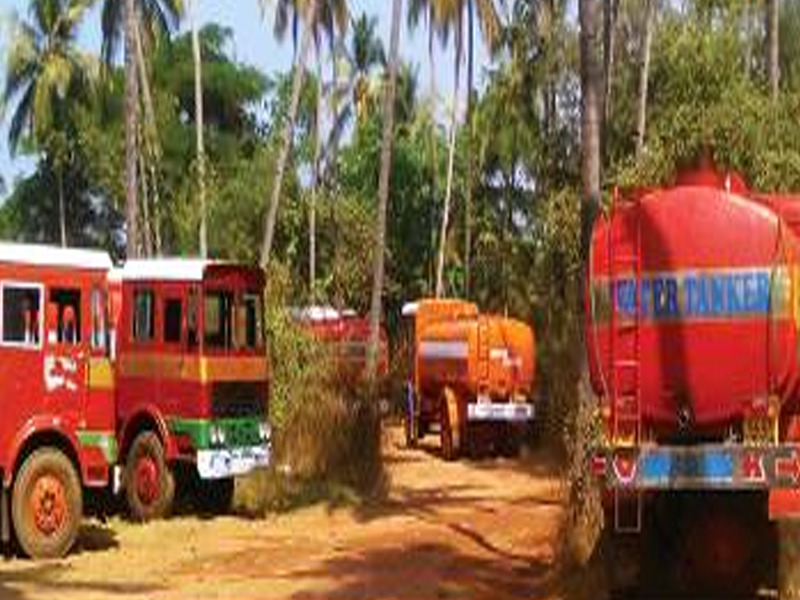Once in five days, Calangute’s 20-year-old shortage peaks
Joseph Zuzarte | TNN | Jan 7, 2019, 05:18 IST Residents blame rampant construction in the village, allege irregularities.
Residents blame rampant construction in the village, allege irregularities.CALANGUTE: All is not well in the state’s tourism hub with locals crying foul over the severe water crisis faced by them. With complaints from Calangute residents pouring in stating that at times they receive water of around one hour every five days, the shortage issue reached such an extent that, at a gram sabha held on November 25, last year, the local panchayat unanimously adopted a resolution not to allow any more mega-building projects until the water situation is rectified.
“Calangute should be declared a ‘water scarce zone’. The panchayat should identify the 100 top consumers and stop the water supply to them. Water should only be given to local residents because commercial units can buy tanker water, which the local residents can’t afford to do,” aggrieved resident Clotildes Braganza said.
 A large number of tankers supply water to hotels and resorts in the beach belt, sourcing the water from wells in neighbouring villages.
A large number of tankers supply water to hotels and resorts in the beach belt, sourcing the water from wells in neighbouring villages.
Braganza said Calangute has been facing water problem for 20 years, despite which more and more buildings continue to be built in the village. Alleging that they have not received any relief despite the PWD minister assuring to release more water to the village, Braganza said, “The village panchayat should stop issuing construction licences to big commercial projects until all residents get water. Stop all NOCs.”
Former sarpanch Joseph Sequeira said that one reason for Calangute’s water shortage was the lack of a dedicated water pipeline. The same pipeline also supplies water to Candolim.
Village sources further alleged that valves had been installed in PWD pipes to stop water from reaching certain areas. Agreeing, Sequeira said that small guesthouses and residences don’t get sufficient water because bigger pipes have been installed to divert water to select favoured hotels in some areas.
Crisis will continue at least till May: Sarpanch
Also, although hotels are not allowed to dig borewells, a number of them are operating borewells in some areas, sources said.
Calangute sarpanch Shawn Martin said the water shortage problem will continue at least till May 2019 when new water storage tanks, currently under construction near the Calangute bus stand, will be ready. At present there is only one overhead tank with a capacity of 150 cum in Calangute.
“Once the two new tanks are ready, the water storage capacity in Calangute will go up by around 18 times,” Martin said. The new water storage facility will have two tanks, one on the ground level and another overhead, with a pumping station in the middle. “By the time the water reaches the tank there is hardly any pressure for it to go up, so it will first be filled up in the tank on the ground and then pumped up into the overhead tank,” he said. The new tanks are being built at a cost of Rs 2.5 crore.
The Calangute panchayat has also recently sent a panchayat resolution to the water resources department asking for a pipeline to Calangute from the proposed new water treatment plant at Guirim. The survey work for the new pipeline is currently on. “We need more water coming to the tanks so that we get water for more hours in Calangute,” Martin said.
Sequeira said that if there was sufficient water supply to fill the present overhead tank to capacity then water could be supplied to the whole of Calangute. But this never happens due to the shortage, he added.
Deputy speaker and Calangute MLA Michael Lobo said the state government is working to resolve Calangute’s water shortage issue. “There is a proposal pending with the finance department for augmentation of water supply to the Bardez coastal belt by increasing the treatment capacity at the Assonora water treatment plant and laying a new pipeline from Guirim. Once it is approved and work order issued, it will be completed in six months,” Lobo said, adding that the proposed water treatment plant at Guirim will take some time as the land acquisition process is still going on. “The new pipeline will be joined to the existing PWD pipeline at Guirim.”
A while ago a borewell had been sunk at Bamontolle, a small lake in Gauravaddo. “This is currently non-functional. If that borewell is reused, it can at least cater to Gauravaddo,” Sequeira said.
“Calangute should be declared a ‘water scarce zone’. The panchayat should identify the 100 top consumers and stop the water supply to them. Water should only be given to local residents because commercial units can buy tanker water, which the local residents can’t afford to do,” aggrieved resident Clotildes Braganza said.

Braganza said Calangute has been facing water problem for 20 years, despite which more and more buildings continue to be built in the village. Alleging that they have not received any relief despite the PWD minister assuring to release more water to the village, Braganza said, “The village panchayat should stop issuing construction licences to big commercial projects until all residents get water. Stop all NOCs.”
Former sarpanch Joseph Sequeira said that one reason for Calangute’s water shortage was the lack of a dedicated water pipeline. The same pipeline also supplies water to Candolim.
Village sources further alleged that valves had been installed in PWD pipes to stop water from reaching certain areas. Agreeing, Sequeira said that small guesthouses and residences don’t get sufficient water because bigger pipes have been installed to divert water to select favoured hotels in some areas.
Crisis will continue at least till May: Sarpanch
Also, although hotels are not allowed to dig borewells, a number of them are operating borewells in some areas, sources said.
Calangute sarpanch Shawn Martin said the water shortage problem will continue at least till May 2019 when new water storage tanks, currently under construction near the Calangute bus stand, will be ready. At present there is only one overhead tank with a capacity of 150 cum in Calangute.
“Once the two new tanks are ready, the water storage capacity in Calangute will go up by around 18 times,” Martin said. The new water storage facility will have two tanks, one on the ground level and another overhead, with a pumping station in the middle. “By the time the water reaches the tank there is hardly any pressure for it to go up, so it will first be filled up in the tank on the ground and then pumped up into the overhead tank,” he said. The new tanks are being built at a cost of Rs 2.5 crore.
The Calangute panchayat has also recently sent a panchayat resolution to the water resources department asking for a pipeline to Calangute from the proposed new water treatment plant at Guirim. The survey work for the new pipeline is currently on. “We need more water coming to the tanks so that we get water for more hours in Calangute,” Martin said.
Sequeira said that if there was sufficient water supply to fill the present overhead tank to capacity then water could be supplied to the whole of Calangute. But this never happens due to the shortage, he added.
Deputy speaker and Calangute MLA Michael Lobo said the state government is working to resolve Calangute’s water shortage issue. “There is a proposal pending with the finance department for augmentation of water supply to the Bardez coastal belt by increasing the treatment capacity at the Assonora water treatment plant and laying a new pipeline from Guirim. Once it is approved and work order issued, it will be completed in six months,” Lobo said, adding that the proposed water treatment plant at Guirim will take some time as the land acquisition process is still going on. “The new pipeline will be joined to the existing PWD pipeline at Guirim.”
A while ago a borewell had been sunk at Bamontolle, a small lake in Gauravaddo. “This is currently non-functional. If that borewell is reused, it can at least cater to Gauravaddo,” Sequeira said.
































All Comments ()+^ Back to Top
Refrain from posting comments that are obscene, defamatory or inflammatory, and do not indulge in personal attacks, name calling or inciting hatred against any community. Help us delete comments that do not follow these guidelines by marking them offensive. Let's work together to keep the conversation civil.
HIDE